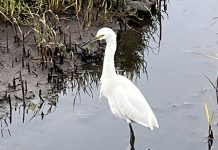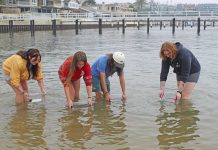A recent study found widespread contamination of various toxins in sport fish along the California coast, including locations in Newport Bay.
The study found that methylmercury and PCBs pose the most widespread potential health concerns to consumers from fish caught on the California coast.
“There was moderate contamination along all the urban coastlines,” said Southern California Coastal Water Research Project Deputy Director Ken Schiff, an author on the report. A couple of species and a few specific locations seemed to have high concentrations though, he added.
This is the first state wide survey of contaminants in fish that people consume in several decades, Schiff said.
Officials from three state water monitoring programs recently presented their findings from the first year of a coordinated two-year screening survey of contaminants in sport fish in California coastal waters.
The Surface Water Ambient Monitoring Program from the State Water Resources Control was the lead author of the report, in close collaboration with the Southern California Bight Regional Monitoring Program and the Regional Monitoring Program for Water Quality in the San Francisco Estuary.
The statewide screening study is an initial step in an effort to evaluate the extent of chemical contamination in sport fish from California’s coast. The survey is part of the state’s comprehensive bioaccumulation monitoring program for California surface waters.
The first year focused on the urban areas of Southern California and the San Francisco bay, which were divided into sections, the size of which was dependent on fishing popularity. One of those sections was Newport Bay.
The study was not comprehensive enough to provide information for consumption guidelines, but none of the locations sampled had all species of fish under the California Office of Environmental Health Hazard Assessment thresholds.
In the first year of this statewide screening study, 2291 fish from 36 species were collected from 42 locations on the California coast.
“The city has been working with inland cities trying to deal with all these issues,” said councilwoman and Mayor Pro Tem Nancy Gardner. “I think most people would agree that even eating fish from the bay in moderation is not a problem… The main thing is we are dealing with these contaminants in a very aggressive way and I think we can look forward to a time when even the upper bay will be an area where we can have our mussels and things actually edible.”
The city has actually had some proposals to do some mussel farming in the bay and harbor already, she added.
“On the whole, we are slowly improving,” she said.
OEHHA would provide specific consumption advice for fish taken from many water bodies in California.
There are already fish advisories in place for Southern California, Schiff said. The advisories are issued by the Office of Environmental Health Hazard Assessment and can be found on their website, www.oehha.ca.gov/fish.html. They inform consumers what fish should and shouldn’t be eaten, as well as consumption threshold levels.
“Our area here in Newport Beach is in the yellow zone,” according to the report, said Randy Seton, a Newport Beach resident involved with water quality.
The report lists contaminants found in certain fish that could potentially be dangerous for some people, Seton said.
“My main concern is the fact that there are signs made to let the public know,” and they should be posted, Seton said. “(It is) a moral obligation to anybody that fishes in our waters…To let people know so they (won’t) have any problems from this. I would want to know and I’m sure the public would also. ”
The city hasn’t decided whether or not to post signs yet, Gardner said.
“One problem is that we have so many signs that after a point people don’t read them… The second issue is: Are people going to pay attention? There have been areas (with signs posted)…and people still fish,” she said. “So we’ll have to consider how we want to deal with this, we haven’t made a decision at this point.”
The city of Newport Beach has been very proactive with water quality, Seton said, but the bottom line is, the information needs to be given to the public, he said, giving them the facts so people can make educated decisions.
The information about the study and its findings can be found online, Schiff said. The Office of Environmental Health Hazard Assessment and state water board’s websites both have helpful information.
The state water board handles water quality monitoring and all of their data can be found on their website, www.swrcb.ca.gov.
The study did find that certain species of fish had higher concentrations of specific contaminants than others.
Mackerel seems to be low on the list while sharks are at the top, Schiff said.
The Newport Bay area, within the middle Orange County section, had one of the species above the limited consumption threshold, white croaker.
“That makes sense,” that white croakers are higher in contaminants, Schiff said. “They are a bottom feeder (and) a lot of (contaminants) come from the mud and sediments.
Three of the main toxins tested were methylmercury, PCB, and DDT.
Mercury is a worldwide contaminant, Schiff said, locally, most of the mercury is left over from when gold miners put it in the water to help find gold, Schiff said, so the higher levels were near the SF bay.
A contaminant that was found in the Newport Bay area is dichlorodiphenyltrichloroethane, or DDT, which is a type of pesticide that was banned in the early 1970s.
What causes the higher concentrations here, Schiff said, are the remnants from a factory in Torrance that manufactured DDT and discharged large quantities of the chemical.
Even though it was banned in 1972, it doesn’t break down easily. It’s half-life is well over 100 years, Schiff added.
Another contaminant found locally is polychlorinated biphenyl, commonly called PCB.
It’s not a pesticide, but it does have a chemical structure similar to DDT, was also banned in the 1970s, and has a half-life of over 100 years. PCBs come from electronics, like transformers.
“I would call it an industrial chemical,” Schiff said.
Out of those three chemicals the mercury was the biggest surprise, Schiff said, because of its widespread, moderate contamination, there was no real spatial pattern.
“It’s new information,” Schiff said.
Overall, the bay is fairly clean though, Gardner said, and most people would be fine eating fish from the bay in moderation, she added.
“If you’re judicious about the amount that you eat and are careful and you’re not in a (sensitive state) like a pregnant woman… But for most of us we can go out and eat some fish in the bay and not suffer any ill effects… We’re not going to eat a fish and keel over,” Gardner said. “I just think that residents should be aware, which I think that they are, that Newport Beach has really been a leader in water quality efforts… And this is the direction we’re continuing in.”






Great article Sara, kinda reminds me of the movie “Jaws”. Well, the Mayor Pro-Tem can eat all the bay fish she wants (my bet is zero), I won’t be! I only care about pregnant mothers, infants, and children, having the facts as the warnings point out.
David Balboa Island:
Sound comments and POV from the Mayor Pro-Tem The picture of the fish for the article are not caught in Newport Bay because they are deeper water pelagic rockfish. Bioaccumulation is the question because cinabar is a native mineral in the watershed. The name Redhill in Tustin is not a clever name, but rather the source of raw cinabar from the 1870’s. Methyl mercury is refined by man and is the important chemical indicator intake accumulation. Source point is still a big question in the lower bay.
FYI, White croaker and other croakers, corvina are common in the bay (even white seabass), and caught frequently when fished for. These are also consumed by local dolphins that hunt frequently in the bay (look into this for “bioaccumulation”, connecting dead dolphins found in our bay). There’s much more than what this study points to, and many other bay species were not mentioned or tested by SCCWRP. Our bay has been turned into a flood control channel for the County, with a still growing watershed, the end of the pipe is the harbor entrance. Making light of facts is irresponsible and prejudice. We as the “City” tell folks what not to do with signs everywhere. So if nobody drops dead, its OK for infants to possibly get physical/mental impairments from consuming toxic fish caught here in Newport only, and not be warned? This applies to coastal ocean fishing as well as documented “hot spots” in the bay!!! SCCWRP findings of toxics in upper Newport bay 2010, showed levels of DDT, DDE and mercury exceeding EPA limits the mullet and bay anchovies tested. Its “cinnabar”, and its red ore containing mercury sulfide, not “Ethylmercury” which is the worst of mercury found in environmental toxic studies that impair the biota. So nice try, talk about smoke and mirrors…